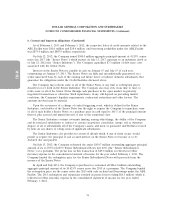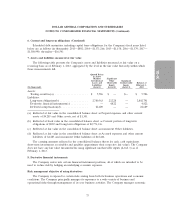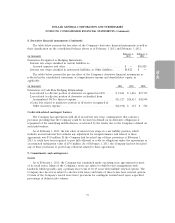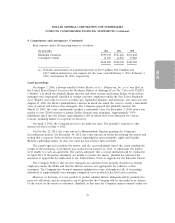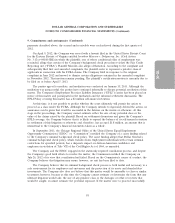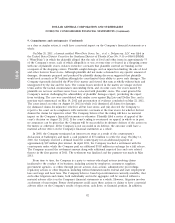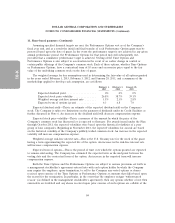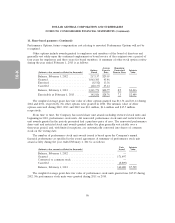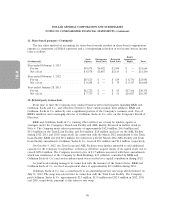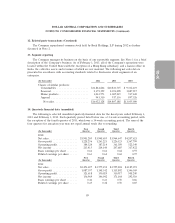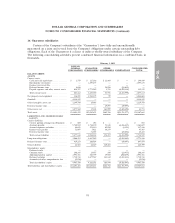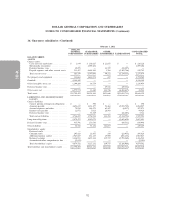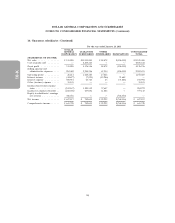Dollar General 2012 Annual Report Download - page 163
Download and view the complete annual report
Please find page 163 of the 2012 Dollar General annual report below. You can navigate through the pages in the report by either clicking on the pages listed below, or by using the keyword search tool below to find specific information within the annual report.
10-K
DOLLAR GENERAL CORPORATION AND SUBSIDIARIES
NOTES TO CONSOLIDATED FINANCIAL STATEMENTS (Continued)
11. Share-based payments (Continued)
Assuming specified financial targets are met, the Performance Options vest as of the Company’s
fiscal year end, and as a result the initial and final tranche of each Performance Option grant may be
prorated based upon the date of grant. In the event the performance target is not achieved in any given
annual performance period, the Performance Options for that period may still subsequently vest,
provided that a cumulative performance target is achieved. Vesting of the Time Options and
Performance Options is also subject to acceleration in the event of an earlier change in control or
certain public offerings of the Company’s common stock. Each of these options, whether Time Options
or Performance Options, have a contractual term of 10 years and an exercise price equal to the fair
value of the underlying common stock on the date of grant.
The weighted average for key assumptions used in determining the fair value of all options granted
in the years ended February 1, 2013, February 3, 2012, and January 28, 2011, and a summary of the
methodology applied to develop each assumption, are as follows:
February 1, February 3, January 28,
2013 2012 2011
Expected dividend yield ................... 0% 0% 0%
Expected stock price volatility .............. 26.8% 38.7% 39.1%
Weighted average risk-free interest rate ....... 1.5% 2.3% 2.8%
Expected term of options (years) ............ 6.3 6.8 7.0
Expected dividend yield—This is an estimate of the expected dividend yield on the Company’s
stock. The Company is subject to limitations on the payment of dividends under its Credit Facilities as
further discussed in Note 6. An increase in the dividend yield will decrease compensation expense.
Expected stock price volatility—This is a measure of the amount by which the price of the
Company’s common stock has fluctuated or is expected to fluctuate. For awards issued under the Plan
through October 2011, the expected volatilities were based upon the historical volatilities of a peer
group of four companies. Beginning in November 2011, the expected volatilities for awards are based
on the historical volatility of the Company’s publicly traded common stock. An increase in the expected
volatility will increase compensation expense.
Weighted average risk-free interest rate—This is the U.S. Treasury rate for the week of the grant
having a term approximating the expected life of the option. An increase in the risk-free interest rate
will increase compensation expense.
Expected term of options—This is the period of time over which the options granted are expected
to remain outstanding. The Company has estimated the expected term as the mid-point between the
vesting date and the contractual term of the option. An increase in the expected term will increase
compensation expense.
Both the Time Options and the Performance Options are subject to various provisions set forth in
a management stockholder’s agreement entered into with each option holder by which the Company
may require the employee, upon termination, to sell to the Company any vested options or shares
received upon exercise of the Time Options or Performance Options at amounts that differ based upon
the reason for the termination. In particular, in the event that the employee resigns ‘‘without good
reason’’ (as defined in the management stockholder’s agreement), then any options whether or not then
exercisable are forfeited and any shares received upon prior exercise of such options are callable at the
84


